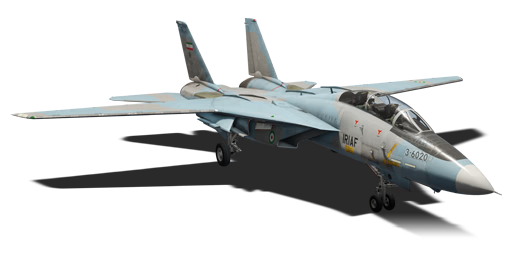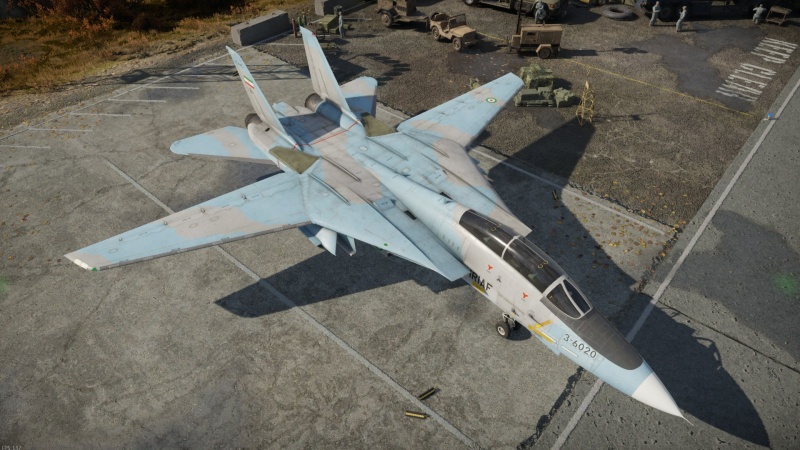F-14A IRIAF (USA)
Contents
Description
Although deemed as one of the most unique aircraft of US Naval Air Force, the Grumman F-14 Tomcat has been the icon of USN since its introduction in 1970 as the fleet air-defense aircraft for carrier battle groups (CVBGs); but US Navy wasn't the only user of Tomcat. Even though efforts has been made to sell Tomcat to US-allied countries, only Iran, which was still under Pahlavi's throne sought for a new interceptor to defend against the menacing, Mach 2.7-capable MiG-25R recon aircraft from neighboring Soviet Union. As soon as January 1974, after the demonstration flights in previous years in US alongside with F-15A, IIAF placed the order of 80 Tomcats and 10-years worth of spare parts for the Pahlavi by mid-1970s; by the 1979 Islamic Revolution which overthrown the throne, there were 79 F-14As delivered to IIAF before the new IRIAF took over them. These aircrafts performed outstandingly during the Iraq-Iran War with some losses over Iraqi aircrafts; however the upcoming sanctions to the now-Islamic Iran and the eventual destruction of all remaining Tomcats stored in continental US in view of possible smuggling of spare parts to Iran also means they have to keep the jet operational by cannibalizing other remaining Tomcats. These F-14As also received some upgrades in terms of firepower with domestic modified and sometimes Russian weaponry to keep them up-to-date until new domestic jets or imported jets replace the legendary Tomcat.
The ▄F-14A Tomcat (Early) IRIAF , introduced during Update "Seek & Destroy" as a reward for the 2024 Persian Tomcat event represents the F-14As operated by IRIAF as-of-present with domestic modifications done to enhance its combat capabilities. Although having a deemed obsolete airframe and radar system for its BR, the domestic missiles from Iran or the addition of R-27R1 will make sure the jet is still capable to defend the skies.
General info
Flight performance
| Characteristics | Max speed (km/h at 12,192 m) |
Max altitude (metres) |
Turn time (seconds) |
Rate of climb (metres/second) |
Take-off run (metres) | |||
|---|---|---|---|---|---|---|---|---|
| AB | RB | AB | RB | AB | RB | |||
| Stock | 2,202 | 2,191 | 16764 | 24.9 | 25.3 | 178.4 | 170.5 | 750 |
| Upgraded | ___ | ___ | __._ | __._ | __._ | __._ | ||
Details
| Features | |||||
|---|---|---|---|---|---|
| Combat flaps | Take-off flaps | Landing flaps | Air brakes | Arrestor gear | Drogue chute |
| ✓ | ✓ | ✓ | ✓ | ✓ | X |
| Limits | Wings (km/h) | Gear (km/h) | Flaps (km/h) | Max Static G | |||
|---|---|---|---|---|---|---|---|
| Combat | Take-off | Landing | + | - | |||
| Min sweep | 1,021 | 518 | 1,200 | 873 | 416 | ~10 | ~5 |
| Max sweep | 1,555 | ~11 | ~5 | ||||
| Optimal velocities (km/h) | |||
|---|---|---|---|
| Ailerons | Rudder | Elevators | Radiator |
| < 1,200 | < 850 | < 1,555 | - |
Engine performance
| Engine | Aircraft mass | ||||||||
|---|---|---|---|---|---|---|---|---|---|
| Engine name | Number | Basic mass | Wing loading (full fuel) | ||||||
| Pratt & Whitney TF30-P-412A | 2 | 18,545 kg | 493 kg/m2 | ||||||
| Engine characteristics | Mass with fuel (no weapons load) | Max Gross Weight | |||||||
| Weight (each) | Type | 18m fuel | 20m fuel | 30m fuel | 45m fuel | 62m fuel | |||
| 1,802 kg | Afterburning low-bypass turbofan | 20,750 kg | 20,904 kg | 22,084 kg | 23,854 kg | 25,894 kg | __,___ kg | ||
| Maximum engine thrust @ 0 m (RB/SB) | Thrust to weight ratio @ 0 m (WEP) | ||||||||
| Condition | 100% | WEP | 18m fuel | 20m fuel | 30m fuel | 45m fuel | 62m fuel | MGW | |
| Stationary | 4,860 kgf | 8,019 kgf | 0.77 | 0.77 | 0.73 | 0.67 | 0.63 | _.__ | |
| Optimal | 5,808 kgf (1,555 km/h) |
12,389 kgf (1,200 km/h) |
1.19 | 1.19 | 1.12 | 1.04 | 0.97 | _.__ | |
Survivability and armour
Examine the survivability of the aircraft. Note how vulnerable the structure is and how secure the pilot is, whether the fuel tanks are armoured, etc. Describe the armour, if there is any, and also mention the vulnerability of other critical aircraft systems.
Modifications and economy
Armaments
| Ballistic Computer | ||||
|---|---|---|---|---|
| CCIP (Guns) | CCIP (Rockets) | CCIP (Bombs) | CCRP (Bombs) | EEGS |
| |
|
|
|
|
Offensive armament
The F-14A IRIAF (USA) is armed with:
- 1 x 20 mm M61A1 cannon, cheek-mounted (676 rpg)
- 60 x countermeasures
Suspended armament
The F-14A IRIAF (USA) can be outfitted with the following ordnance:
| Default weapon presets | |
|---|---|
| |
Usage in battles
Describe the tactics of playing in the aircraft, the features of using aircraft in a team and advice on tactics. Refrain from creating a "guide" - do not impose a single point of view, but instead, give the reader food for thought. Examine the most dangerous enemies and give recommendations on fighting them. If necessary, note the specifics of the game in different modes (AB, RB, SB).
Pros and cons
Pros:
- Retains the maneuverability of US F-14A
- Surprisingly good turn radius for such a huge jet with fully-deployed wing
- Elevator with rolling capabilities which enhance roll rate
- RWR with surprising wide of spectrum of radio wave detectable against aerial/ground target
- Radar with multiple modes for different scenarios
- Wide variety of weapon selection
- Retains AIM-54A since stock and access to Fakour 90
- SARH AAMs such AIM-7E2, Sedjil and Russian R-27R1
- Access to the devastating Yasser rocket with very high explosive content
- Sufficient bombs to be a makeshift attacker
Cons:
- Somewhat obsolete avionics
- Radar only has head-on modes and lacks IFF
- RWR with no target identification and tracking warning
- Risks of wing ripping at intensive maneuver at higher speeds
- Easily detectable ARH AAMs due to its long burn time
- Yasser can accidentally shot down players themselves if set with fuse distance
- Fuel hungry engine with high chance of overheating
- Somewhat insufficient countermeasures
History
Describe the history of the creation and combat usage of the aircraft in more detail than in the introduction. If the historical reference turns out to be too long, take it to a separate article, taking a link to the article about the vehicle and adding a block "/History" (example: https://wiki.warthunder.com/(Vehicle-name)/History) and add a link to it here using the main template. Be sure to reference text and sources by using <ref></ref>, as well as adding them at the end of the article with <references />. This section may also include the vehicle's dev blog entry (if applicable) and the in-game encyclopedia description (under === In-game description ===, also if applicable).
Media
Excellent additions to the article would be video guides, screenshots from the game, and photos.
See also
Links to the articles on the War Thunder Wiki that you think will be useful for the reader, for example:
- reference to the series of the aircraft;
- links to approximate analogues of other nations and research trees.
External links
Paste links to sources and external resources, such as:
- topic on the official game forum;
- other literature.
| USA jet aircraft | |
|---|---|
| Fighters | |
| F-4 | F-4C Phantom II · F-4E Phantom II · F-4J Phantom II · F-4S Phantom II |
| F-5 | F-5A · F-5C · F-5E · F-20A |
| F-8 | F8U-2 · F-8E |
| F-80 | F-80A-5 · F-80C-10 |
| F-84 | F-84B-26 · F-84F · F-84G-21-RE |
| F-86 | F-86A-5 · F-86F-25 · F-86F-2 · F-86F-35 |
| F-89 | F-89B · F-89D |
| F-100 | F-100D |
| F-104 | F-104A · F-104C |
| F-14 | F-14A Early · F-14B |
| F-15 | F-15A · F-15C MSIP II |
| F-16 | F-16A · F-16A ADF · F-16C |
| F9F | F9F-2 · F9F-5 · F9F-8 |
| Other | P-59A · F2H-2 · F3D-1 · F3H-2 · F4D-1 · F11F-1 |
| Strike Aircraft | |
| FJ-4 | FJ-4B · FJ-4B VMF-232 |
| A-4 | A-4B · A-4E Early |
| A-6 | A-6E TRAM |
| A-7 | A-7D · A-7E · A-7K |
| AV-8 | AV-8A · AV-8C · AV-8B Plus · AV-8B (NA) |
| A-10 | A-10A · A-10A Late · A-10C |
| B-57 | B-57A · B-57B |
| F-105 | F-105D |
| F-111 | F-111A · F-111F |





